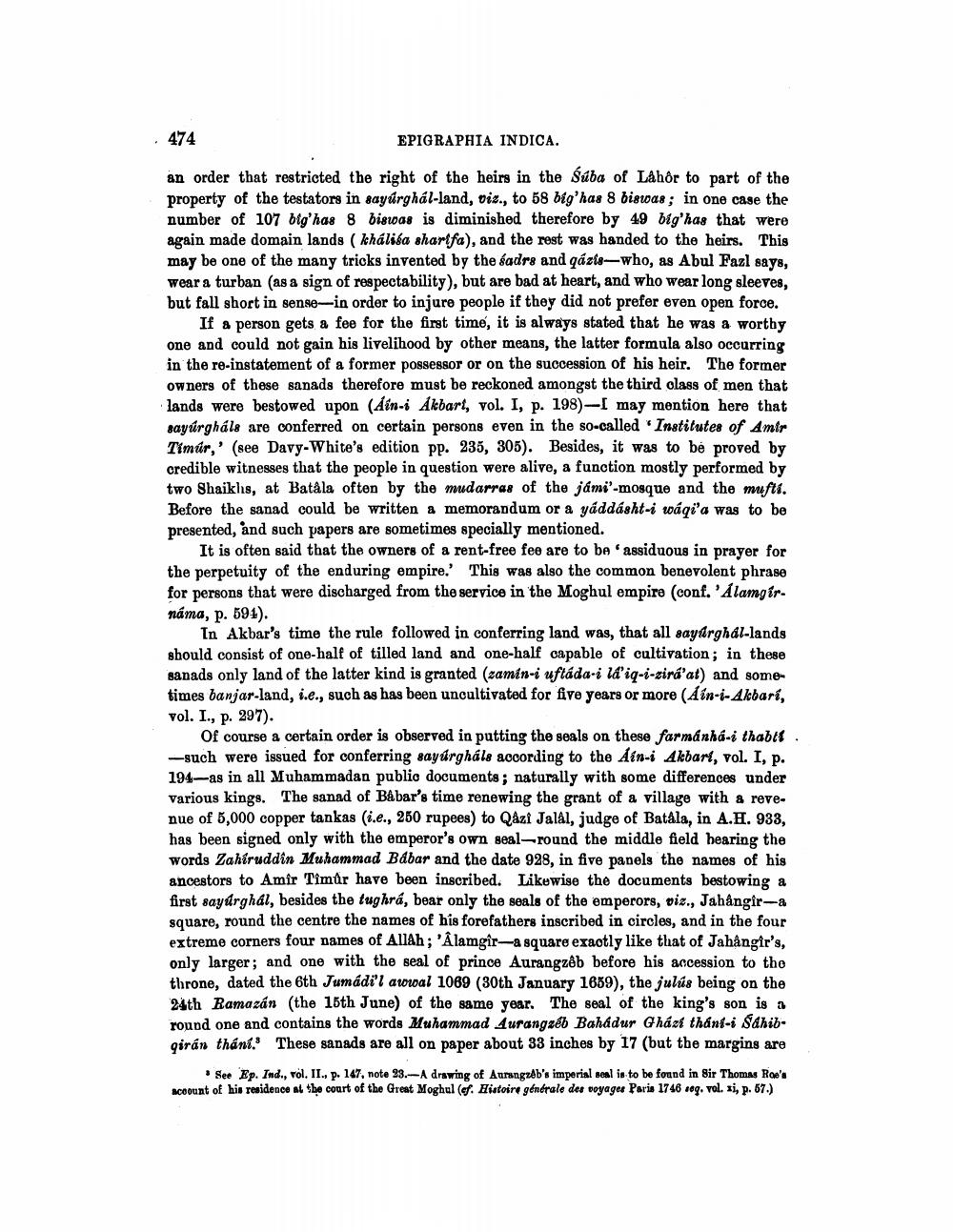________________
474
EPIGRAPHIA INDICA.
an order that restricted the right of the heirs in the Suba of Lâhôr to part of the property of the testators in sayúrghál-land, viz., to 58 big' has 8 biswas; in one case the number of 107 big' has 8 biswas is diminished therefore by 49 big' has that were again made domain lands (khálisa shartfa), and the rest was handed to the heirs. This may be one of the many tricks invented by the sadrs and qázis-who, as Abul Fazl says, wear a turban (as a sign of respectability), but are bad at heart, and who wear long sleeves, but fall short in sense-in order to injure people if they did not prefer even open force.
If a person gets a fee for the first time, it is always stated that he was a worthy one and could not gain his livelihood by other means, the latter formula also occurring in the re-instatement of a former possessor or on the succession of his heir. The former owners of these sanads therefore must be reckoned amongst the third class of men that lands were bestowed upon (Ain-i Akbart, vol. I, p. 198)-I may mention here that sayúrgháls are conferred on certain persons even in the so-called 'Institutes of Amir Timur,' (see Davy-White's edition pp. 235, 305). Besides, it was to be proved by credible witnesses that the people in question were alive, a function mostly performed by two Shaikhs, at Batåla often by the mudarras of the jámi'-mosque and the mufti. Before the sanad could be written a memorandum or a yaddásht-i wáqi'a was to be presented, and such papers are sometimes specially mentioned.
It is often said that the owners of a rent-free fee are to be assiduous in prayer for the perpetuity of the enduring empire.' This was also the common benevolent phrase for persons that were discharged from the service in the Moghul empire (conf. 'Alamgirnáma, p. 591).
In Akbar's time the rule followed in conferring land was, that all sayúrghal-lands should consist of one-half of tilled land and one-half capable of cultivation; in these sanads only land of the latter kind is granted (zamin-i uftáda-i la'iq-i-zirá'at) and sometimes banjar-land, i.e., such as has been uncultivated for five years or more (Áín-i-Akbarí, vol. I., p. 297).
Of course a certain order is observed in putting the seals on these farmánhá-i thabt. -such were issued for conferring sayúrgháls according to the Ain-i Akbart, vol. I, p. 194-as in all Muhammadan public documents; naturally with some differences under various kings. The sanad of Babar's time renewing the grant of a village with a revenue of 5,000 copper tankas (i.e., 250 rupees) to Qâzi Jalâl, judge of Batåla, in A.H. 933, has been signed only with the emperor's own seal-round the middle field hearing the words Zahiruddin Muhammad Bábar and the date 928, in five panels the names of his ancestors to Amir Timûr have been inscribed. Likewise the documents bestowing a first sayurghál, besides the tughrá, bear only the seals of the emperors, viz., Jahangir-a square, round the centre the names of his forefathers inscribed in circles, and in the four extreme corners four names of Allah; 'Alamgir-a square exactly like that of Jahangir's, only larger; and one with the seal of prince Aurangzeb before his accession to the throne, dated the 6th Jumadi'l awwal 1069 (30th January 1659), the julús being on the 24th Ramazan (the 15th June) of the same year. The seal of the king's son is a round one and contains the words Muhammad Aurangzeb Bahadur Ghází thání-i Sahibqirán thání. These sanads are all on paper about 33 inches by 17 (but the margins are
* See Ep. Ind., vol. II., p. 147, note 23.-A drawing of Aurangzeb's imperial seal is to be found in Sir Thomas Roe's account of his residence at the court of the Great Moghul (ef. Histoire générale des voyages Paris 1746 seq. vol. xi, p. 57.)




